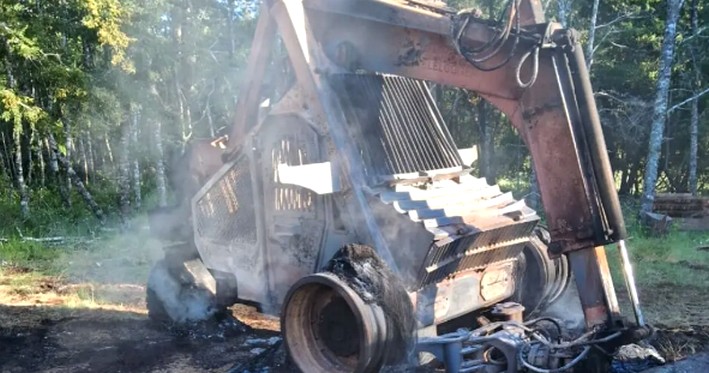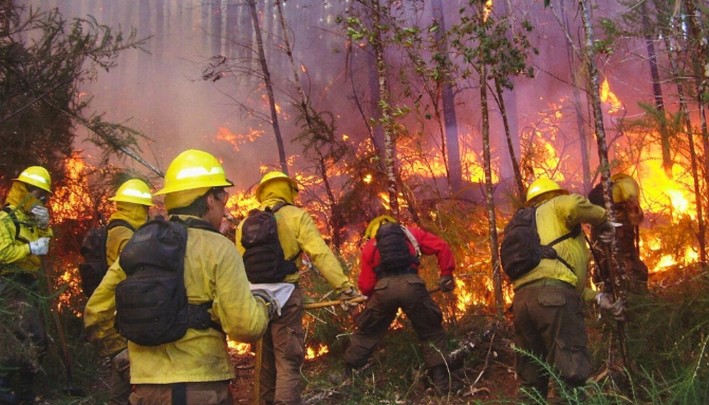“13% fewer fires, but there is still a long way to go”: Assessment by the Regional Director of Conaf in Biobío
For the new regional director of the National Forestry Corporation (Conaf), Esteban Krause, the occurrence of wildfires is a concerning issue; likewise, simultaneous outbreaks along highways raise alarms about intentionality in the area.
The start of summer brings with it a dangerous trio. Heat, wind, and low relative humidity in the territories are the three variables that foster the occurrence of forest fires. According to information from the National Forestry Corporation (Conaf), around 1,113 hectares have burned in Biobío at the beginning of the season.
Additionally, a critical point of the summer season in Biobío is the suspicion of intentionality in fires recorded in Penco, where eight simultaneous outbreaks were reported in less than 12 hours. All this unfolds amid parliamentary discussions on bills seeking to toughen penalties for those who cause fires and another motion proposing the creation of instruments to prevent and adequately respond to such cases.
Esteban Krause, regional director of Conaf Biobío, spoke about this and more in an interview with Diario Concepción.
– How can intentional fires in Biobío be stopped?
– For some time now, we’ve been working with good coordination among forestry companies on a methodology to involve communities in the responsibility they bear regarding forest fires, whether by taking preventive measures or through oversight and the possibility of reporting situations that raise concerns or pose risks.
– How can this intentionality be identified?
– It generally repeats more frequently in certain localities. There are certain characteristics at the start of a fire that may, in one way or another, signal intentionality. First, the persistent recurrence of fires in specific territories or localities. Second, in some areas like Hualqui, Penco, and Los Álamos, there were many simultaneous outbreaks in the same area.
That’s why forestry companies, Conaf, and also the Investigative Police and Carabineros have established wildfire investigation brigades—units that allow us to determine the causes of fires. This also enables us not only to take legal action when there is sufficient evidence to bring a case to court but also to develop prevention plans tailored to the realities of each zone.
– So far, a little over a thousand hectares have burned this summer season, which was already forecast months ago as complex. What is your assessment of the situation?
– The Biobío region is the second in the country, after the Metropolitan region, in terms of the number of fires, according to general statistics. But in the current season, our records show 365 fires in total, covering 1,013.79 hectares.
That means we have 13% fewer fires, which at this point is a good indicator, but there is still a long way to go in the season. And we are concerned about the occurrence—each fire can turn into a major blaze, a tragedy, as we’ve seen before.
In terms of occurrence and area affected, the Biobío region has lower numbers than other regions in the country and lower than last year. At the same point last year, we had 420 fires. Regionally, we are one of the areas that has reduced fire occurrence. But we are still, after the Metropolitan region, the region with the most fires to date.
It’s important to further strengthen prevention efforts. I believe the Regional Government has already been involved for some time, and we want them to continue committing to prevention—for example, with resources.
– Along those lines, how would you rate the work with the newly arrived mayors?
– In most cases, I’d say the mayors are very attuned to the issue. We must take advantage of their willingness to coordinate well and work together. However, there are some weaknesses in certain territories, mainly regarding personnel and resources. Often, the emergency officer handles other municipal duties, which can cause delays. But the effort is there.
– And you, Director, have just rejoined Conaf during a complex period due to fire occurrences. What has been the biggest challenge for you?
– I was, let’s say, born and raised in public service at Conaf, so I’m returning to an institution I know—its protocols, way of working, and efforts. But I also want to acknowledge the significant effort made in the last two years; the government has injected substantial resources.
Today, we have an agreement that allows us to monitor rural areas directly through company towers. We’re working to attack fires regardless of ownership—whether it’s a large company, a small landowner, or a medium-sized one—with strong coordination. Private company resources, plus Conaf’s and municipal resources in key tasks like oversight, have allowed us to tackle fires very quickly.
We have better numbers in terms of area addressed, mainly because the initial attack is very fast. We’re working with a “single strike” approach—deploying all available personnel, machinery, and aerial equipment quickly and in significant numbers to prevent fires from growing.
– On that note, how would you rate collaboration with the private sector? Do you believe they take responsibility for protecting communities living near forest plantations?
– Companies have a program called the Prevention Network, which they’ve been working on for years. What we call “prepared communities” involves training those living on the periphery—near or somewhat farther from their lands—so that everyone takes responsibility for preventing fires.
I’ve attended various Communal Disaster Risk Management Committees (Cogrid), where forestry companies also participate as neighbors—neighbors with responsibilities in the areas where their plantations are located.
– Regarding the wildfire prevention and mitigation bill, this motion is in its final stages. Is it negative that it hasn’t been approved yet?
– It’s a good tool that will enable more prevention and oversight measures. Currently, from a legal standpoint, both municipalities and Conaf itself face restrictions in compelling landowners to take preventive measures. I believe the law mainly addresses that.
– Concerning the bill to toughen penalties for intentional fires, is it important to establish such measures?
– It’s important, but it’s also crucial to increasingly equip both law enforcement and the Public Prosecutor’s Office. There will need to be training on the evidence required for a judge to convict an accused person. There’s an entire process that will improve judicialization and legal proceedings to ensure cases result in convictions for those truly responsible for these fires.
– Whether due to negligence or intent?
– Exactly. For example, if someone using an electric machine causes a fire, that person should also face consequences—just as if I were driving carelessly and hit someone. Maybe I didn’t mean to, but if I wasn’t attentive to road conditions, I’m responsible for the accident. The same should apply to fires caused by negligence.
– What is your message to the public?
– To reinforce the responsibility each of us holds. Forestry companies, Conaf, and municipalities fight fires, but they didn’t start them. The responsibility for their occurrence—which we hope to minimize—is a cultural issue. It’s about being aware of our surroundings and the risks. So, I urge everyone to work together to reduce risks and stay alert to any signs of intentionality.
Source:Diario Concepción

















